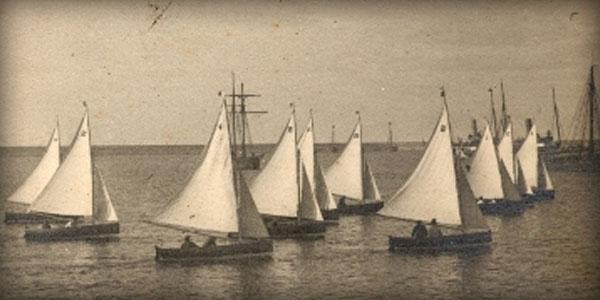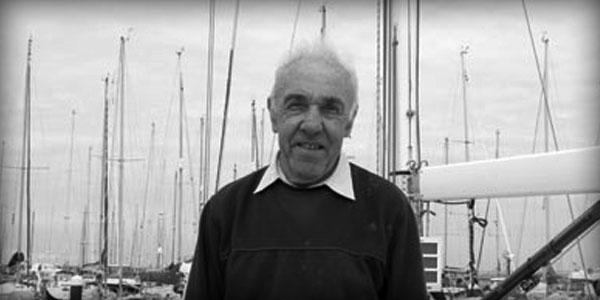John Brennan
The Harbour has many unique features but one of the most remarkable is a human one – boat builder John Brennan who has worked in the Harbour for the last 65 years.
Born in 1932, John began work in the Harbour when he was ten years old in 1942. His uncle Ted ran a rowing boat hire business from the slipway next to the Carlisle Pier and John would help him whenever he could. When Ted died in a tragic accident in 1944, his brother Isaac, John’s father, who worked for the then Dun Laoghaire Borough Corporation took over the business and John continued at his side.
The boats were hired for six pence (about three cents today) per person per hour and were available from ten o’clock in the morning until ten o’clock at night in the summer time. John remembers in particular how business lifted each year during the second week in July as many visitors from Northern Ireland came to Dun Laoghaire during their traditional holiday week.
One of the characters in the boat hire business who John remembers was a man called Jem Pluck who made his oars from solid oak. The huge weight of these oars meant his boats could never go far and thus the risk of boats being abandoned elsewhere or stolen was greatly reduced. Even fifty years ago, boats were at risk. Since hirers only paid when they returned the boat, some people tried to avoid paying and just abandoned the boat around the harbour or further afield. John remembers some boats being rowed across the Dublin Bay to Sutton and left there. Others were left closer to home in Blackrock and along the southern coast of the Bay.
The Coopers were another family John remembers in the boat hire business then.
He also remembers the East Pier gun battery in use by the army during World War Two as it fired blanks at a German aircraft over the Harbour to warn it that it was over a neutral country. Years later, in 1956, John worked in the battery removing the old wooden floor. One feature of the floor was that it had no metal nails, only wooden nails called trunnels. Metal nails could not be used for fear of ever causing a spark that might ignite the explosive materials that were in the battery for so many years.
In 1948 John was apprenticed as a boat builder to Eddie Gray who worked in the Coal Harbour and he spent the next five years acquiring his qualification, which included two years at the Technical School on Eblana Avenue.
The Harbour has changed considerably in John’s time there. He remembers the old mail boats to Holyhead – especially the Princess Maud – and the train line that ran out onto the Carlisle Pier. The waterfront sailing clubs have all expanded outwards – at one stage he could row under the National Yacht Club deck.
John recalls the fishing business run by Brigham Young from a shed called the fish bank, where the Motor Yacht Club now stands. This involved baiting long lines of anything between 140 and 200 hooks and then taking them out in a 14 foot rowing boat to places like Sandymount, leaving them overnight and coming back the next day to see what had been hooked.
Handling boats was heavy work – it took four men up to two hours to get a boat out of the water and up to the turntable in the Boat Yard. Other heavy work was shovelling coal. The coal boats from the west coast of England coming into the Harbour were also a familiar sight to John up until the early 1950s. A railway track ran from the existing station across the current Irish Lights site and onto Traders Wharf to take the coal away.
There are several buildings and features, now disappeared that John remembers well in and around the Harbour:
- The Dun Laoghaire morgue was situated between Traders Wharf and the Royal Irish Yacht Club. There was also a Board of Works stone yard there;
- The old sailors home in the Coal Harbour where visiting sailors and seamen could sleep in a cot free of charge. While the home was out of use in John’s time, he remembers the cots and Charlie Blackmore who lit a fire there and offered cups of tea;
- The very rudimentary “French toilet”, made of granite, on the old quay with a drop of 20 or 30 feet straight through to the sea below;
John worked as a shipwright for the Commissioners of Irish Lights for 16 years between 1953 and 1969 and for many years he also did maintenance work for the RNLI in Dun Laoghaire, polishing the metal work and testing the engines to ensure the boat was always ready for action. He retired from the boat hire business in 1954 as problems with vandalism and people not returning boats to avoid paying made the enterprise very difficult.
He remembers the Harbour Swim, of which his father was an active organiser, from what he calls the age of “iron men and wooden ships”. The swim used to go through the tunnel under the Carlisle Pier, on to the Coal Quay, over to the West Pier, on to the Melampus Buoy and back to Rogan’s Slip.
The township regatta was another popular event which was a week long series of boat racing involving a stevedores race using shovels instead of oars in rowing boats. Skiff racing was also very popular and involved 25 foot long boats competing against each other. Clubs still exist today in Ringsend, Greystones and Dalkey. A popular application was a mixture of stale porter and black lead which was painted onto the boat bottoms. When dry, the polished surface was said to help the boats travel faster.
While John has many memories of the Harbour, he has also left a huge legacy in terms of the many wooden boats he built that still sail there. The water wags (the original dinghy which instigated the concept of one design boats) are still going strong in the Harbour after 105 years and many enjoy their continued seaworthiness and beauty to John’s skilful repairs and maintenance. He has also built a number of Shannon One Design (SOD) boats which are sailed on the Shannon and Lough Derg. John has also built a number of Glen class keelboats and their long 35 foot masts made of Oregon pine pose a special, but enjoyable challenge.
The Mermaid class owes a considerable debt to John – he built 17 of the boats that still sail in Dun Laoghaire. He recalls that in 1961 it cost £475 to put these boats on the water, a considerable sum in those days.
The optimist has become one of the most widely used entry level sailing boats for junior sailors and are made of fibreglass nowadays. However, in an earlier age they were made of wood and John remembers building one in the 1960s in the front room of his house. When it was time to take it out, there was a half inch to spare in getting it out the door! In those days, an oppie cost about £30 for the hull.
While the demand for new wooden boats is light these days, John enjoys good health and continues to work in the boat building and repair business in and around Dun Laoghaire Harbour with his two sons Edwin and Nigel.





